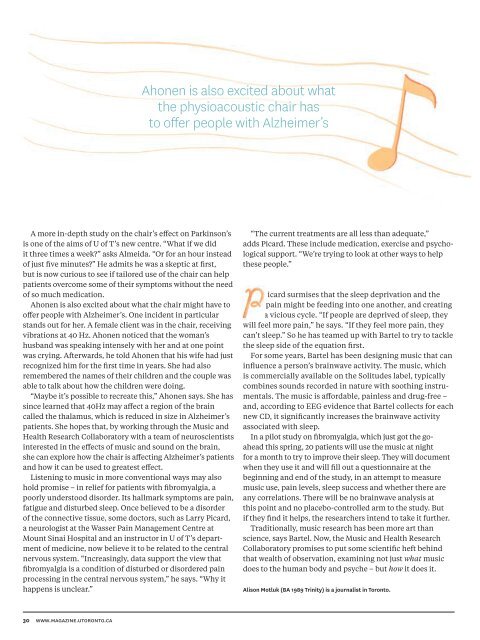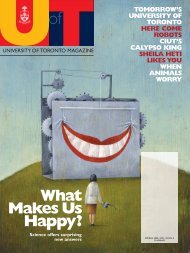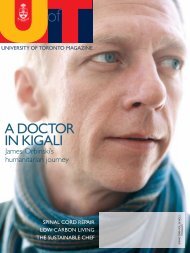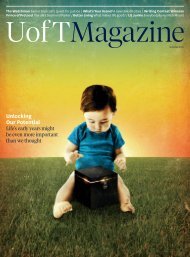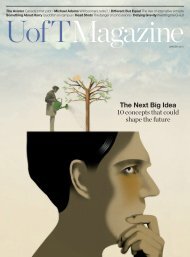What's the solution to Toronto's traffic problems? - University of ...
What's the solution to Toronto's traffic problems? - University of ...
What's the solution to Toronto's traffic problems? - University of ...
Create successful ePaper yourself
Turn your PDF publications into a flip-book with our unique Google optimized e-Paper software.
Ahonen is also excited about what<br />
<strong>the</strong> physioacoustic chair has<br />
<strong>to</strong> <strong>of</strong>fer people with Alzheimer’s<br />
A more in-depth study on <strong>the</strong> chair’s effect on Parkinson’s<br />
is one <strong>of</strong> <strong>the</strong> aims <strong>of</strong> U <strong>of</strong> T’s new centre. “What if we did<br />
it three times a week” asks Almeida. “Or for an hour instead<br />
<strong>of</strong> just five minutes” He admits he was a skeptic at first,<br />
but is now curious <strong>to</strong> see if tailored use <strong>of</strong> <strong>the</strong> chair can help<br />
patients overcome some <strong>of</strong> <strong>the</strong>ir symp<strong>to</strong>ms without <strong>the</strong> need<br />
<strong>of</strong> so much medication.<br />
Ahonen is also excited about what <strong>the</strong> chair might have <strong>to</strong><br />
<strong>of</strong>fer people with Alzheimer’s. One incident in particular<br />
stands out for her. A female client was in <strong>the</strong> chair, receiving<br />
vibrations at 40 Hz. Ahonen noticed that <strong>the</strong> woman’s<br />
husband was speaking intensely with her and at one point<br />
was crying. Afterwards, he <strong>to</strong>ld Ahonen that his wife had just<br />
recognized him for <strong>the</strong> first time in years. She had also<br />
remembered <strong>the</strong> names <strong>of</strong> <strong>the</strong>ir children and <strong>the</strong> couple was<br />
able <strong>to</strong> talk about how <strong>the</strong> children were doing.<br />
“Maybe it’s possible <strong>to</strong> recreate this,” Ahonen says. She has<br />
since learned that 40Hz may affect a region <strong>of</strong> <strong>the</strong> brain<br />
called <strong>the</strong> thalamus, which is reduced in size in Alzheimer’s<br />
patients. She hopes that, by working through <strong>the</strong> Music and<br />
Health Research Collabora<strong>to</strong>ry with a team <strong>of</strong> neuroscientists<br />
interested in <strong>the</strong> effects <strong>of</strong> music and sound on <strong>the</strong> brain,<br />
she can explore how <strong>the</strong> chair is affecting Alzheimer’s patients<br />
and how it can be used <strong>to</strong> greatest effect.<br />
Listening <strong>to</strong> music in more conventional ways may also<br />
hold promise – in relief for patients with fibromyalgia, a<br />
poorly unders<strong>to</strong>od disorder. Its hallmark symp<strong>to</strong>ms are pain,<br />
fatigue and disturbed sleep. Once believed <strong>to</strong> be a disorder<br />
<strong>of</strong> <strong>the</strong> connective tissue, some doc<strong>to</strong>rs, such as Larry Picard,<br />
a neurologist at <strong>the</strong> Wasser Pain Management Centre at<br />
Mount Sinai Hospital and an instruc<strong>to</strong>r in U <strong>of</strong> T’s department<br />
<strong>of</strong> medicine, now believe it <strong>to</strong> be related <strong>to</strong> <strong>the</strong> central<br />
nervous system. “Increasingly, data support <strong>the</strong> view that<br />
fibromyalgia is a condition <strong>of</strong> disturbed or disordered pain<br />
processing in <strong>the</strong> central nervous system,” he says. “Why it<br />
happens is unclear.”<br />
“The current treatments are all less than adequate,”<br />
adds Picard. These include medication, exercise and psychological<br />
support. “We’re trying <strong>to</strong> look at o<strong>the</strong>r ways <strong>to</strong> help<br />
<strong>the</strong>se people.”<br />
icard surmises that <strong>the</strong> sleep deprivation and <strong>the</strong><br />
pain might be feeding in<strong>to</strong> one ano<strong>the</strong>r, and creating<br />
a vicious cycle. “If people are deprived <strong>of</strong> sleep, <strong>the</strong>y<br />
will feel more pain,” he says. “If <strong>the</strong>y feel more pain, <strong>the</strong>y<br />
can’t sleep.” So he has teamed up with Bartel <strong>to</strong> try <strong>to</strong> tackle<br />
<strong>the</strong> sleep side <strong>of</strong> <strong>the</strong> equation first.<br />
For some years, Bartel has been designing music that can<br />
influence a person’s brainwave activity. The music, which<br />
is commercially available on <strong>the</strong> Solitudes label, typically<br />
combines sounds recorded in nature with soothing instrumentals.<br />
The music is affordable, painless and drug-free –<br />
and, according <strong>to</strong> EEG evidence that Bartel collects for each<br />
new CD, it significantly increases <strong>the</strong> brainwave activity<br />
associated with sleep.<br />
In a pilot study on fibromyalgia, which just got <strong>the</strong> goahead<br />
this spring, 20 patients will use <strong>the</strong> music at night<br />
for a month <strong>to</strong> try <strong>to</strong> improve <strong>the</strong>ir sleep. They will document<br />
when <strong>the</strong>y use it and will fill out a questionnaire at <strong>the</strong><br />
beginning and end <strong>of</strong> <strong>the</strong> study, in an attempt <strong>to</strong> measure<br />
music use, pain levels, sleep success and whe<strong>the</strong>r <strong>the</strong>re are<br />
any correlations. There will be no brainwave analysis at<br />
this point and no placebo-controlled arm <strong>to</strong> <strong>the</strong> study. But<br />
if <strong>the</strong>y find it helps, <strong>the</strong> researchers intend <strong>to</strong> take it fur<strong>the</strong>r.<br />
Traditionally, music research has been more art than<br />
science, says Bartel. Now, <strong>the</strong> Music and Health Research<br />
Collabora<strong>to</strong>ry promises <strong>to</strong> put some scientific heft behind<br />
that wealth <strong>of</strong> observation, examining not just what music<br />
does <strong>to</strong> <strong>the</strong> human body and psyche – but how it does it.<br />
Alison Motluk (BA 1989 Trinity) is a journalist in Toron<strong>to</strong>.<br />
30 www.magazine.u<strong>to</strong>ron<strong>to</strong>.ca


